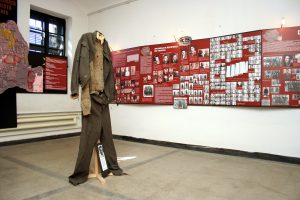One of the museum’s most important rooms is dedicated to the anticommunist resistance movement in the mountains. The map of Romania on which most of the resistance groups are marked reveals the scale of the phenomenon. Case studies present the partisan groups that operated on both sides of the Făgăraș Mountains,
in the Banat, Vrancea, Bukowina, Dobrudja and the Western Carpathians. (The resistance in Maramureș is presented separately in Room 74 on the second floor.) The anti-communist resistance became visible immediately after the communists took power, when many were arrested for opposing communist purges in the army, collectivisation or the subjugation of the education system. Not only did those who resisted suffer themselves, but also their relatives: the siblings and parents who helped them were in their turn arrested. Confronted with this massive wave of aggression, an important part of the armed resistance took to the mountains. The majority of them organised themselves into assemblies or groups or partisans, and the Romanian mountains were full of them. Thus between 1945 and 1959 we find partisans in the both the Eastern and Central Carpathians, in Făgăraş, Retezat, Semenic, the Western Carpathians, the Obcine of Bukowina, the forests of Babadag, and the mountains of Gutâi and Ţibleş.
The groups that were formed (on average between ten and forty people) did not represent a major threat to the communist authorities, although as long as they remained free they undermined the regime’s claim to have complete control over the whole country. They were composed of young people, old men, women (some of whom were even pregnant or had small children), peasants, former army officers, solicitors, doctors, students and workers. There were people of all ages, social classes and political orientations. They were armed with pistols and machine-guns left over from the war, but always suffered from an acute shortage of ammunition.
They were supported by villagers who brought them food and clothes and often offered shelter too. Communist propaganda labelled them all “bandits”. It is most impressive how these fighters succeeded so many times in eluding the pursuing Securitate, which mustered “posses” to catch them dead or alive.
However, the fact that the secret police terrorised the families and relatives of the fighters in the mountains, expelled their children school, and employed other savage methods, led many of them to surrender in order to spare their loved ones from torture. Some were sentenced to long prison terms and had their assets seized as punishment for “plotting against the social order”. The majority were killed. Those who killed them received rewards and promotion.
The anti-communist resistance was a spontaneous phenomenon, and it seems that the various groups were not co-ordinated at the national level.
posted in: First Floor









